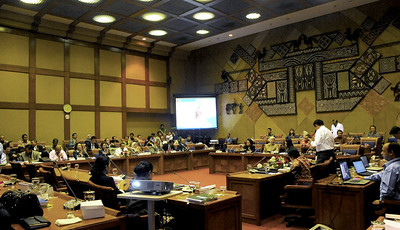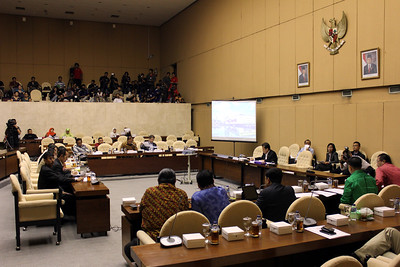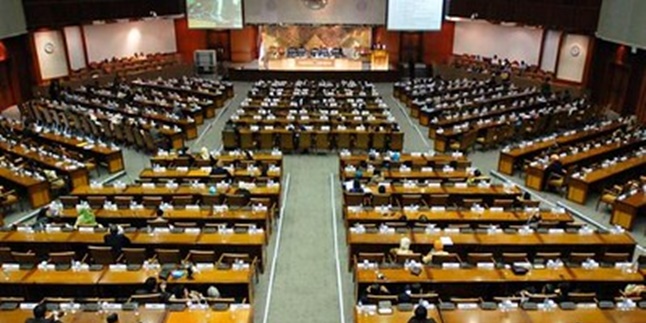Kapanlagi.com - The term "motion of no confidence" is certainly not unfamiliar to the general public. Lately, this term has been widely discussed and become trending when the government passed the Omnibus Law on Job Creation. Not only once, the term "motion of no confidence" has been used several times before. In general, motion is a decision resulting from a meeting.
Motion is a word that often appears in protests or demonstrations. It's no wonder that the word motion, especially the term "motion of no confidence," seems unfamiliar to the ears. However, the fact is that many people still do not understand what motion is.
So, to better understand the meaning of motion as a meeting decision, read the following explanation summarized from various sources.
1. What is a Motion?

(credit: flickr)
In the Indonesian Dictionary (KBBI), the meaning of the word 'mosi' is a decision of a meeting. Furthermore, in KBBI it is also explained that 'mosi' can be divided into two types, namely 'mosi tidak percaya' (vote of no confidence) and 'mosi percaya' (vote of confidence). Referring to this meaning, it is not surprising that the word 'mosi' is closely related to the government. Specifically, with the government's actions in establishing a new regulation, such as the recent enactment of the Omnibus Law on Job Creation.
2. Motion in Debate Activities

(credit: flickr)
Apparently, 'mosi' is not only interpreted as the result or decision of a meeting. The term 'mosi' is also found in debate activities as an important element. Debate itself is an activity carried out through discussion and exchange of opinions about a certain topic. In a debate, each participant must be able to provide reasons to defend their respective arguments.
'Mosi' is one of the important elements in a debate. In debate activities, 'mosi' is defined as a term used to refer to the topic raised in the debate. This means that the 'mosi' or topic must be determined before the debate begins. 'Mosi' in debate has several criteria that must be fulfilled.
The criteria for 'mosi' in debate activities are as follows:
1. 'Mosi' must focus on an event or issue.
2. 'Mosi' must be interesting to discuss.
3. 'Mosi' must be balanced (between pros and cons, so it can be debated and not cornering one party).
4. 'Mosi' generally must have a solution (the solution can be found).
3. Meaning of Motion of No Confidence
As mentioned earlier, in the KBBI (Indonesian Dictionary), a motion is the result of a meeting decision that can be divided into two, namely a motion of no confidence and a motion of confidence. However, the motion of no confidence seems to be more attention-grabbing. The motion of no confidence is often proclaimed to convey the aspirations of the people towards government decisions that are considered unfair and unwise.
Finally, the motion of no confidence echoed when the government ratified the Omnibus Law on Job Creation. The motion of no confidence was proclaimed by demonstrators to voice their aspirations. However, it turns out that the motion of no confidence is not something new. According to merdeka.com, the motion of no confidence has been used since the 19th century. However, its usage is still relatively rare.
According to Wikipedia, one of the historical instances of the motion of no confidence occurred in 1782. At that time, the British forces suffered a defeat in the Battle of Yorktown (1781) during the American Revolution. As a result, the British Parliament then decided that they "no longer trusted their minister at that time". The Prime Minister at that time, Lord North, responded by submitting his resignation letter to King George III.
From this brief history, it can be concluded that a vote of no confidence is one of the tools or instruments to tightly control the politics of governance. A vote of no confidence is a form of expression of distrust from the House of Representatives towards the government's policies. A vote of no confidence can be a pattern in monitoring the accountability of the government system, especially in parliamentary form.
This is as stated on the official website of the Republic of Austria parlement.gv.at. The website explains that members of the National Council can withdraw their confidence in the Federal Government or some of its members through a valid resolution.
In Indonesian history, a vote of no confidence not only occurred during the uproar of the Omnibus Law some time ago. Previously, in September 2019. However, at that time, a vote of no confidence was not issued by the DPR against the government. At that time, the vote of no confidence was actually proposed by student representatives who demanded the cancellation of the revision of the KPK Law because it was considered not siding with the people.
4. Motion of Confidence

(credit: flickr)
In addition to the motion of no confidence, there is also what is called a motion of confidence. Although rarely mentioned, it is also important to understand the meaning of the motion of confidence. The motion of confidence is a motion that states that the representatives believe in the government's policies.
Within an organization, a motion of confidence will automatically arise when the policies made by the organization's officials are trusted by its members. Therefore, a motion of confidence is never proclaimed like a motion of no confidence, which arises as a form of protest.
Those are some explanations about the motion as a decision of a meeting. Hopefully, it is useful and can broaden your knowledge.
(kpl/psp)
Disclaimer: This translation from Bahasa Indonesia to English has been generated by Artificial Intelligence.















